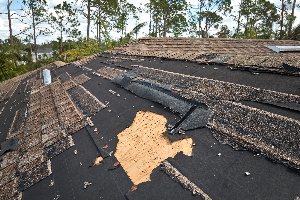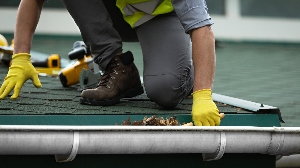Most homeowners will face roof problems at some point, but many don't know how to spot the warning signs before small issues become expensive disasters. The most common roof problems include leaks around penetrations like vents and chimneys, damaged or missing shingles, and poor drainage that leads to water pooling.
Understanding what causes these problems and recognizing early warning signs can save thousands of dollars in repair costs. Many roof issues start small but grow quickly when ignored, turning a simple shingle replacement into a major structural repair.
This guide explains the root causes of roof damage, helps homeowners identify problems before they worsen, and provides clear guidance on when to repair versus replace a roof.
Here’s what you need to know:
- What causes common roof problems in homes
- Most common roofing issues and their warning signs
- How to prevent costly roof repairs
- Should you repair or replace your roof?
Keep reading! Learning these basics protects both the home and the budget from unexpected roofing emergencies.
What causes common roof problems in homes
Most roof problems start from three main sources: weather damage combined with normal aging, poor air flow that traps moisture, and mistakes made during the original installation. These factors often work together to create bigger issues over time.
How weather and age impact roof durability
Weather puts constant stress on roofing materials. Rain, snow, and ice create cycles of freezing and thawing that crack shingles and loosen flashing.
Strong winds lift shingle edges and tear off loose pieces. Hail creates dents and holes that let water inside. UV rays from the sun break down roofing materials and make them brittle.
Age makes these problems worse. Old shingles lose their protective granules and become less flexible. The adhesive strips that hold shingles down weaken over time.
Flashing around chimneys and vents develops gaps as metal expands and contracts. Gutters pull away from the roof edge due to ice buildup and debris weight.
Most asphalt shingles last 20-25 years. After this point, weather damage happens much faster because the materials can no longer bounce back from storms.
According to Forbes Home, roof lifespans vary by material—asphalt shingles ~15–30 years, metal 40–70 years, and slate/clay 50+ years—which helps gauge when repairs no longer beat.
The role of poor ventilation and moisture buildup
Attics need proper air flow to stay dry and cool. Hot air should escape through ridge vents at the top while cool air enters through soffit vents under the eaves.
Without good ventilation, heat builds up in summer and reaches 150 degrees or higher. This extreme heat warps roof decking and causes shingles to crack from below.
Moisture problems start in winter. Warm air from the house rises into the attic and hits the cold roof deck. This creates condensation that soaks into wood and insulation.
Trapped moisture leads to several serious issues:
- Mold growth in attic spaces
- Rotted roof decking and rafters
- Ice dams that force water under shingles
- Warped framing that creates uneven roof lines
According to the U.S. Department of Energy (DOE), ice dams form when heat from the house warms the roof, causing meltwater that refreezes at the eaves and can force water under shingles; improving air sealing and attic insulation is a primary prevention strategy.
Poor ventilation also makes energy bills higher because HVAC systems work harder to cool the house.
Why improper installation leads to early roof failure
Many roof problems trace back to installation mistakes. Contractors who rush the job or lack experience create weak spots that fail within a few years.
Flashing installation causes the most problems. Roof penetrations like vents, chimneys, and skylights need careful sealing. Poor flashing work lets water seep into the house structure.
Shingle installation errors include wrong nail placement and inadequate overlap. Nails driven too high or too low create loose spots. Shingles that don't overlap enough expose the roof deck to weather.
Wrong materials for the climate also cause early failure. Some shingles can't handle extreme temperature swings or high winds in certain areas.
Inadequate roof decking support leads to sagging and structural problems. Contractors who space rafters too far apart or use thin plywood create weak foundations that can't support heavy loads.
Most common roofing issues and their warning signs
Roof problems often start small but can quickly become costly disasters if left untreated. Early detection of leaks, damaged shingles, structural issues, and material deterioration can save thousands in repair costs.
Identifying leaks, missing shingles, and sagging areas
Water stains on ceilings or walls are the most obvious signs of roof leaks. Homeowners should look for brown or yellow marks that appear after storms. These stains often show up weeks after the actual leak starts.
According to the U.S. Environmental Protection Agency (EPA), wet materials should be dried within 24–48 hours to prevent mold growth, highlighting the need for rapid cleanup after roof leaks.
Missing or damaged shingles create entry points for water. Wind can lift shingles and tear them away completely. Homeowners can spot missing shingles by looking for bare patches on the roof or finding shingle pieces in their yard after storms.
Sagging areas indicate serious structural problems. A roof should appear straight and level from the ground. Any dips, curves, or drooping sections mean the roof structure is weakening.
Common signs of sagging include:
- Visible dips when viewed from the street
- Doors and windows that stick or won't close properly
- Cracks in interior walls near the roofline
- Uneven roof lines
Storm damage roof repair often becomes necessary after high winds or hail. Homeowners should inspect their roof after every major weather event.
Spotting granule loss and weakened flashing early
Asphalt shingles lose granules over time, but excessive loss signals trouble. Homeowners can check their gutters for granule buildup after rain. A small amount is normal, but large quantities indicate shingle deterioration.
Bald spots on shingles mean they're losing their protective coating. These areas appear darker than surrounding shingles and feel smooth to the touch. Shingles with significant granule loss need replacement soon.
Flashing protects joints where the roof meets walls, chimneys, or vents. Damaged flashing allows water to seep into the home. Homeowners should look for:
Problem
What to look for
Rust or corrosion
Brown or orange stains on metal flashing
Loose sections
Flashing that moves when touched
Cracks or holes
Visible gaps in the flashing material
Missing caulk
Gaps between flashing and roof materials
Roof leak repair often involves fixing damaged flashing around these problem areas.
How to tell when roof damage is more than cosmetic
Surface damage like minor granule loss or small scratches may look bad but don't always require immediate repair. However, certain signs indicate structural problems that need quick action.
Exposed nail heads mean shingles are pulling away from the roof deck. This creates openings for water and wind damage. Homeowners should never ignore exposed nails or fasteners.
Interior signs of serious damage include water dripping during rain, musty odors in the attic, or daylight visible through roof boards. These problems require immediate professional attention.
Multiple damaged areas across the roof often indicate the entire system is failing. When repairs would cost more than half the price of replacement, homeowners should consider a new roof instead of patching individual problems.
How to prevent costly roof repairs
Smart prevention starts with regular inspections and timely maintenance to catch small issues before they become expensive problems. Property owners can save thousands by following seasonal care routines and making minor repairs when needed.
Scheduling regular roof inspections for early detection
Professional roof inspection services should examine every roof at least once per year. Spring and fall are the best times for these checks.
Homeowners can also do basic monthly inspections from the ground. They should look for missing or damaged shingles, sagging areas, and debris buildup.
Key inspection areas include:
- Gutters and downspouts
- Flashing around chimneys and vents
- Shingle condition and alignment
- Attic spaces for leaks or water damage
After major storms, additional inspections help find new damage quickly. Early detection prevents small problems from spreading to other roof areas.
Professional inspectors use special tools to spot issues that homeowners might miss. They check for loose fasteners, worn sealants, and structural problems.
Seasonal maintenance tips to extend roof life
Spring maintenance tasks:
- Clear gutters of winter debris
- Check for ice damage from winter storms
- Trim tree branches near the roof
- Inspect and clean roof vents
Summer heat can damage roofing materials over time. Homeowners should check for cracked or curled shingles during hot months.
Fall preparation includes:
- Removing leaves from gutters
- Checking flashing before winter weather
- Sealing small cracks or gaps
- Ensuring proper attic ventilation
Winter roof maintenance focuses on preventing ice dams. Good insulation and ventilation stop warm air from melting snow unevenly.
Regular cleaning prevents moss and algae growth that can damage shingles. Simple roof maintenance done each season keeps materials in good condition longer.
When to invest in roof sealing or minor repairs
Small repairs cost much less than major roof replacement. Homeowners should fix problems when they first appear rather than waiting.
Repair these issues immediately:
- Single damaged or missing shingles
- Small leaks around flashing
- Loose or damaged gutters
- Minor cracks in roofing materials
Roof sealing works best on roofs that are still in good overall condition. Sealants protect against water damage and extend roof life by several years.
Professional repairs make sense for problems involving structural damage or multiple areas. DIY fixes work for simple shingle replacement or minor caulking jobs.
The cost of minor repairs is usually under $500. Major roof replacement can cost $10,000 or more for average homes.
Timing matters for repair investments. Spring and fall offer the best weather conditions for roofing work and often better contractor pricing.
Should you repair or replace your roof?
The decision depends on several key factors including the roof's age, extent of damage, and repair costs compared to replacement expenses. Getting professional input helps homeowners make the most cost-effective choice for their specific situation.
Factors to consider before choosing a repair or replacement
Roof age plays a major role in this decision. Asphalt shingles typically last 20-25 years, while metal roofs can last 50+ years.
If the roof is less than 10 years old, repairs usually make sense. Roofs over 20 years old often benefit more from replacement.
Damage extent matters just as much as age. Small problems like a few missing shingles or minor leaks can be repaired easily.
Multiple leaks, widespread shingle damage, or structural issues signal the need for replacement. Water damage inside the home often costs more than a full roof replacement.
Energy efficiency improves with newer roofing materials. Old roofs may lack proper insulation or ventilation, leading to higher energy bills.
Home value increases with a new roof. Replacement adds significant resale value, while repeated repairs may not.
Weather exposure in your area affects the decision. Homes in harsh climates with frequent storms may need replacement sooner than those in mild weather zones.
How to estimate the cost of roof repair vs. replacement
Repair costs typically range from $300-$1,500 for minor issues. Major repairs can cost $3,000-$7,000 depending on the problem size.
Replacement costs vary widely based on materials and home size. Basic asphalt shingle replacement averages $8,000-$15,000 for most homes.
The 25% rule helps guide decisions. If repair costs exceed 25% of replacement cost, replacement usually makes more financial sense.
Compare multiple quotes from licensed contractors. Prices can vary significantly between companies for the same work.
Insurance coverage may affect costs. Some policies cover storm damage repairs but not wear-and-tear issues.
Factor in long-term expenses. Frequent repairs on an aging roof often cost more than one replacement over time.
Financing options exist for both repairs and replacements. Many contractors offer payment plans for larger projects.
When professional roofing services make the best choice
Safety concerns make professional help essential. Roof work involves serious fall risks and requires proper equipment and training.
Complex problems need expert diagnosis. What appears as a simple leak may indicate deeper structural issues only professionals can identify.
Insurance claims require professional documentation. Contractors know how to work with insurance companies and provide necessary paperwork.
Warranty protection comes with professional installation. Most reputable contractors guarantee their work for several years.
Building codes must be followed for any major roof work. Professional contractors understand local requirements and permit processes.
Material selection benefits from expert knowledge. Professionals can recommend the best materials for your climate, home style, and budget.
Get multiple professional opinions before making final decisions. Different contractors may see different solutions to the same problem.
Conclusion
Regular roof inspections are essential for every homeowner. Checking your roof twice yearly in spring and fall helps catch problems early.
Most roofing problems can be prevented with proper maintenance. Small repairs cost much less than major replacements.
Homeowners should watch for early warning signs like water stains or missing shingles. Professional inspections help identify issues that might not be visible from the ground.
Some repairs require professional help. Complex issues like structural damage or extensive leaks need expert attention.
Taking care of roof problems quickly protects homes from water damage. It also extends the roof's lifespan and saves money over time.
A proactive approach works best for roof maintenance. Regular care prevents small issues from becoming expensive disasters.
Schedule a professional roof inspection with Michaelis today to pinpoint issues, prioritize repairs, and protect your home from costly leaks.




.avif)

